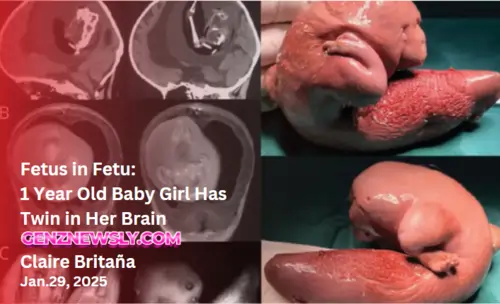
Fetus in Fetu: A 1-year-old baby girl is diagnosed with a rare condition where a malformed twin was found inside her brain. Learn more about this unusual case.
A 1-year-old child was taken to the doctors due to delays in development and a large head. What they discovered amazed everyone – there was a twin growing inside the child’s brain! This extremely rare condition is called “fetus in fetu,” where one twin gets trapped inside the other during early development. It’s so rare that only a few cases have been recorded in medical history. Doctors had to carry out a complicated surgery to remove the fetus.
Fetus in Fetu (FIF) is a rare medical condition where a baby is born with its undeveloped twin inside its body. This happens in about 1 in 500,000 births. Doctors have reported cases worldwide, including a recent discovery in China, where a 1-year-old girl had FIF.
What is Fetus in Fetu?
How Does It Happen?
Fetus in fetu (FIF) occurs when identical twins start to form in the womb, but one twin doesn’t develop fully. This underdeveloped twin gets trapped inside the other twin early in pregnancy. Instead of growing normally, the trapped twin stays inside the other twin’s body, while the healthy twin grows as expected. The trapped twin may not have a functioning heart or brain and doesn’t develop properly.
The trapped twin can include parts like limbs, bones, and organs, and may look like an undeveloped fetus. As time goes on, it may be surrounded by tissue and appear as a mass inside the host twin’s body. FIF is very rare, with only a few cases recorded in medical history.
In some cases, the trapped twin causes no symptoms, but in others, it may lead to problems like developmental delays, swelling, or pain in the abdomen or head. The usual treatment is surgery to remove the undeveloped twin, and with early treatment, most children recover fully.
How is Fetus in Fetu Different from a Tumor?
FIF is often confused with a teratoma, which is a type of tumor that may have tissues like hair, bones, or teeth. However, FIF is different because it has clear fetal features, such as a spine, arms, or legs. This gives FIF a more organized structure, even though it is underdeveloped, compared to a teratoma, which is usually a disordered mass of tissue.
Teratomas are generally non-cancerous tumors that can grow in places like the ovaries, testicles, or tailbone, but they don’t look like a developing fetus. On the other hand, FIF happens when one twin doesn’t fully develop during pregnancy and gets trapped inside the other twin. The mass inside the host twin may look like a small fetus, with parts like a spine, limbs, or even organs like kidneys or intestines.
Teratomas are usually found in adults, while FIF is often discovered in young children, typically when symptoms like swelling or developmental delays are noticed. Both conditions are rare, but FIF is considered a developmental issue rather than a tumor, and surgery is usually needed to remove the trapped twin.
Symptoms and Diagnosis of Fetus in Fetu
Signs That a Baby May Have Fetus in Fetu
- Swollen belly that grows abnormally large
- Pain or difficulty breathing if the FIF presses on organs
- Slow growth because the undeveloped twin takes up space inside the body
- Developmental delays due to the physical pressure from the trapped twin
- Visible lumps or bumps in the abdomen or head from the mass inside
- Infections or complications if the trapped twin causes internal damage
How Doctors Detect Fetus in Fetu
Doctors use ultrasound, MRI, and CT scans to examine the body. These scans help them find if there are bones, a spine, or other parts of a fetus inside the host twin. An ultrasound uses sound waves to create pictures of the inside, which can reveal the trapped twin. MRI (Magnetic Resonance Imaging) gives detailed images of soft tissues, helping doctors spot any unusual growths. CT (Computed Tomography) scans take X-ray pictures and create a 3D image, which helps doctors see the mass and understand its size and location. These scans help doctors accurately diagnose the condition and plan surgery to remove the underdeveloped twin.
Treatment and Removal
Is Fetus in Fetu Dangerous?
Most cases of Fetus in Fetu are not harmful, but if not treated, the trapped twin can press on organs, causing pain, breathing problems, or infections. This pressure can also affect the growth and health of the host twin. In some cases, the trapped twin may grow larger, leading to more discomfort or serious problems.
Doctors usually recommend surgery to remove the undeveloped twin to avoid further health issues. If the surgery is done early, the host twin typically makes a full recovery and can grow and develop normally. Although the surgery can be challenging, especially if the mass is attached to organs, the outlook is generally positive if treated in time.
How is Fetus in Fetu Removed?
Doctors perform surgery to carefully remove the undeveloped twin, which can be a delicate and complex procedure. Since the trapped twin may be attached to important organs or tissues, surgeons must carefully separate it without causing harm to the surrounding areas.
In a recent case from China, doctors successfully operated on a 1-year-old girl with Fetus in Fetu. The surgery greatly improved her health by removing the trapped twin, which had been causing pain and other health issues. After the surgery, the girl was able to develop more normally and without the complications caused by the condition. This case shows how important it is to catch Fetus in Fetu early and treat it quickly to help the child recover and grow healthily.
Scientific and Ethical Questions
What Makes Fetus in Fetu Interesting to Doctors?
Fetus in Fetu is a medical mystery that helps doctors learn more about how babies grow and develop. By studying these rare cases, scientists can better understand how identical twins form and why some abnormalities happen during early pregnancy. Looking into Fetus in Fetu cases helps researchers discover more about how embryos grow, especially how one twin might not develop fully and ends up trapped inside the other.
These studies also show how cells divide, tissues form, and how genes influence the development of twins. Even though FIF is very rare, the knowledge gained from these cases can help doctors diagnose and treat other complex birth conditions caused by unusual fetal development. Research into FIF continues to provide a clearer picture of human biology and the factors that affect pregnancy and birth.
Are There Ethical Concerns?
Some FIF cases have partial brain tissue, raising ethical questions about whether it is a twin or just a mass of tissue. However, FIF is not considered a separate person because it cannot survive on its own.
Conclusion
Fetus in fetu (FIF) is an extremely rare condition, seen in only a few cases around the world. While it is generally not life-threatening, it’s important to detect and treat it early to ensure the health of the host twin. If FIF goes undiagnosed or untreated, it can cause complications like developmental delays, organ damage, or infections, which is why early intervention is vital.
Doctors often use routine scans, such as ultrasounds, MRIs, or CT scans, to detect FIF, especially if there are signs like an enlarged belly or unusual growth. These scans help doctors spot abnormal growths inside the body and tell the difference between FIF and other conditions like tumors.
Ongoing research into Fetus in Fetu is crucial to understanding what causes the condition. Scientists are exploring the genetic and environmental factors that may lead to its development. By studying these rare cases, researchers hope to uncover more about how twins form and why one might fail to develop properly, which could improve how we detect and treat this condition.
In addition, learning more about Fetus in Fetu can help doctors understand other rare conditions, like teratomas, which share some similarities with FIF but are different. As technology improves and more cases are studied, the medical community is getting a better understanding of FIF, which could lead to better treatments and outcomes for affected children.
Other Stories:
https://genznewsly.com/luckiest-zodiac-signs-for-chinese-new-year-2025/
https://genznewsly.com/deepseek/
Resources:
https://www.facebook.com/share/p/194gACmDzw
About the Author
Claire Britaña excels in various writing styles, adapting seamlessly to different topics and audiences. Her ability to craft compelling narratives and her commitment to meeting deadlines make her an invaluable asset in the fast-paced world of news writing.







